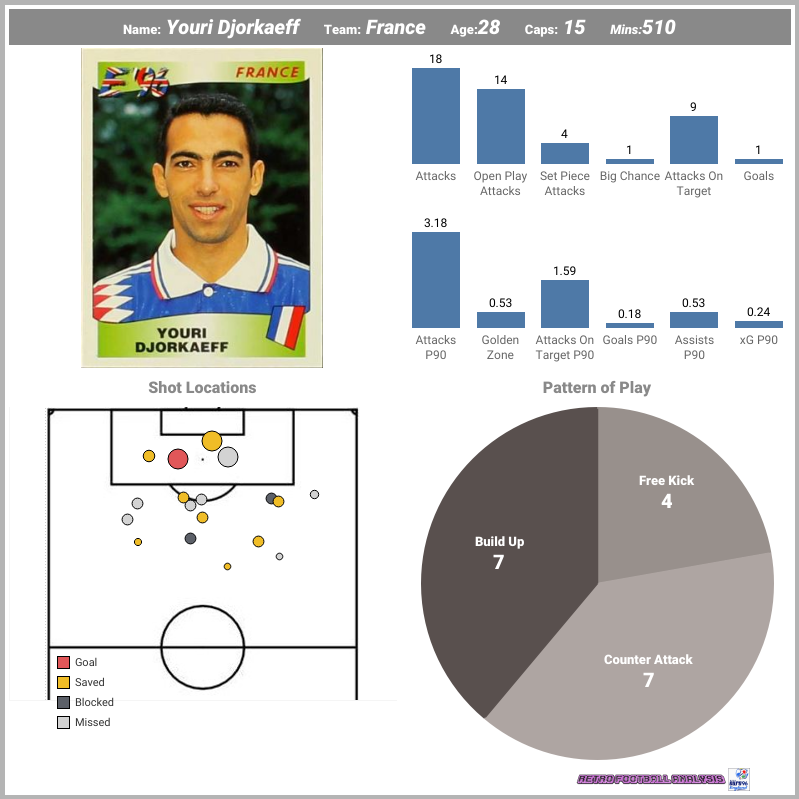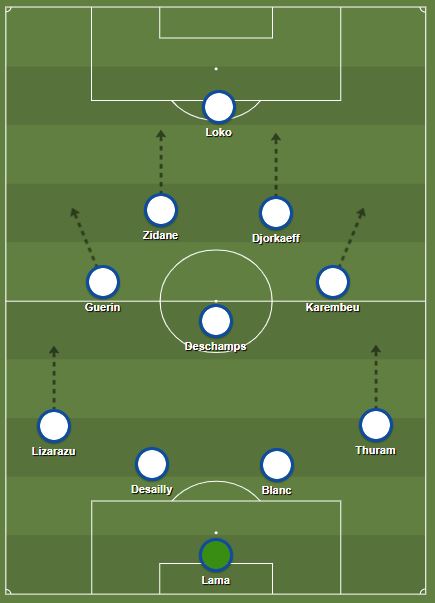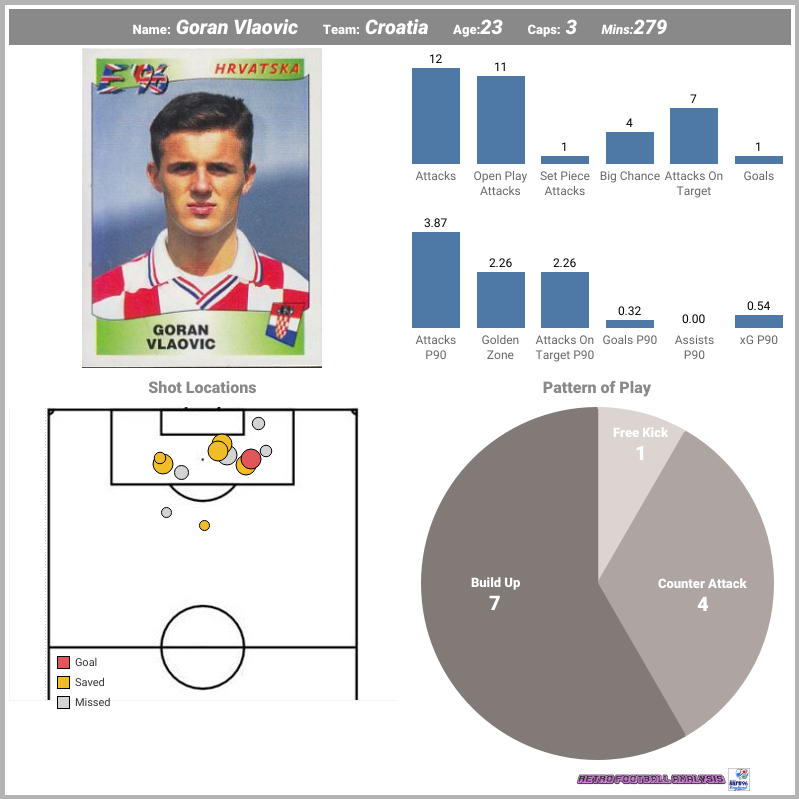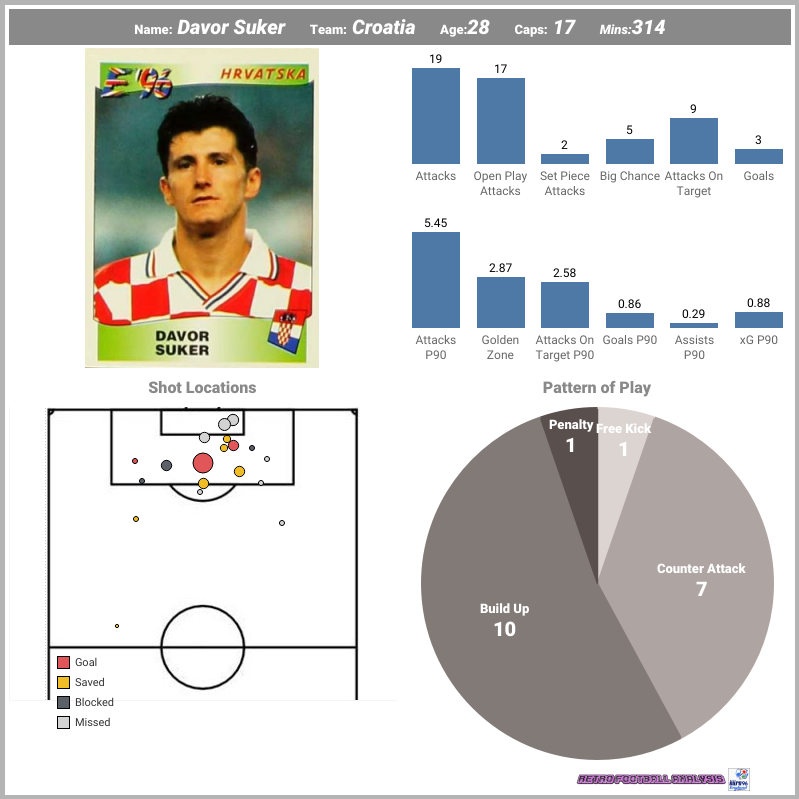Within this article we identify the top 5 highest ranking individual attackers at Euro 96, breaking down why they were so important to their team’s overall attack play.
Top 5 Statistical Attackers
When building an analysis of the best overall attackers at Euro 96 there were of course a wide variety of factors we could bring into the selection. Where we settled on the best judge of attacking performance was to first total each Goals & Assists tally, and then weigh these chances by each individual xG per 90, not including penalty kicks.
Before we get into the top 5 we wanted to give an honorable mention to one elite level performer.
Honorable Mention:
Youri Djorkaeff

In the summer of 1995 Djorkaeff moved from Monaco to Paris Saint-Germain, where he would go onto finish as 3rd top scorer behind Rai and Del Valdes, but during this season would help the Paris side to a 2nd place Ligue 1 finish and the UEFA Cup Winners Cup title. His performances this year and subsequent summer tournament would win him a move to Italian giants Inter Milan, where he would go on to form a striker partnership with Ronaldo.
After the failed 1994 World Cup qualification Aime Jacquet would ring the changes to the French squad, however Djorkaeff was very much considered part of the national sides future and would go on to play a pivotal role in qualification for Euro 96. Djorkaeff would score 5 goals throughout Group 1, and would begin to form an impressive partnership with the talented youth product from Bordeaux, a certain Zinedine Zidane.
When we look at Djorkaeff’s Euro 96 performance, while didn’t make the top 5, his attacking output certainly put him in the conversation. He would take up a more withdrawn role in France’s 4321 system, which gave him the opportunity to both create and be part of the attack, especially in moments of transition where France would use their solid defence to suck puncture opposition attack play and allow their creative talent to spring forward.

Djorkaeff’s dribbling ability allowed him to carry the ball into dangerous areas, which created space for him to shoot from distance on occasion. He also had a fine football brain when selecting the best spaces to progress into the box, doing so in a way that prevented defenders from seeing his runs early and simply picking him up. His attacks per 90 for an attacking midfielder was impressive, as was his attacks on target per 90 given that so many of his efforts are coming from distance. Djorkaeff was also featured in our Chance Creation Analysis piece where he also ranked very highly, so it’s no surprise that he played an important role in France’s progression to the semi finals of Euro 96.
Player #5:
Goran Vlaovic

Goran Vlaovic would go on to be one of the top attackers at Euro 96, but he was very much part of the second string of the side until an opportune moment arose midway through the opening game. Vlaovic had made his international debut for Croatia in 1992 in a friendly match against Australia, however after this match he would go on to make a handful of international appearances in just over three and a half years. Having undergone surgery to remove a blood clot from his brain in 1995, he would only make one appearance in the qualification process, meanwhile Boksic and Suker were firmly establishing themselves as Croatia’s leading strike partnership. A head injury that Boksic picked up against Turkey, and one that would subsequently end his tournament, would provide Vlaovic with an opportunity to get onto the field, and during this match he would score the winning goal in a close fought 1-0 victory. From here he would play out the rest of the tournament as a starter, forming a seamless partnership with Davor Suker in the process.

Vlaovic was with Serie A side Padova heading into this tournament, having scored 13 goals in 23 appearances, and his performances would win him a move to La Liga giants Valencia the following year. Overall Vlaovic’s performance would only return 1 goal, but his attacking potency was clear for all to see. His xG per 90 shows us he gave himself just over 50% chance of scoring in each match, and would return a similar value (50%) in his ability to turn chances into shots on target per game.
Player #4:
Dennis Bergkamp

Prior to Euro 96 Dennis Bergkamp had already acclimated himself into English life, after making a £7.5 Million transfer to Arsenal from Inter Milan. While the fee would be bettered later that month by Liverpools acquisition of Stan Collymore’s for £8.5, at the time of the deal it would be a British transfer record and was very much a statement of intent by Arsenal who had been famously very frugal during the late 80s and early 90s. He would go on to make 33 appearances for Arsenal, scoring 11 goals, but would foster a terrific partnership with club legend Ian Wright, who would finish top scorer with 15 league goals.
Bergkamp had spent much of his time in Italy as a lone striker, so in moving to a twin partnership at Arsenal we began to see how creative he could be as well as deadly in front of goal. For Holland we’d see him start as a central striker in a 3-4-3 system, one that would see him drift into deeper positions to pick up the ball, or pull wide to receive and then dribble toward the goal. In Holland’s final match of Euro 96 he would be deployed as an attacking midfielder behind Kluivert, a role that he had earlier performed a brief cameo in against England, providing the wonderful assist that would see Kluivert score the goal to take them through to the next round.

Even exiting at the Quarter Final stage Holland would create 74 chances in total, only matched by England, and with Bergkamp striking almost 30% of these efforts we see how central he was to the teams attacking patterns. To have only scored once in the four games its clear he would liked to have contributed more to the teams goal tally, but in hitting 2.18 shots per 90 and 2.45 Golden Zone (Central portion of 18 yard box) attacks per 90, he would at least finish as one of the most active strikers at the competition, who had put himself in the most dangerous positions and therefore given himself the best chance of scoring.
Player #3:
Teddy Sheringham

Sheringham would enter Euro 96 having had a terrific run of form at club level with Tottenham Hotspur. While his side would finish in 8th position, he would finish the season as the clubs top goal scorer, bagging 24 goals in all competitions. At International level he had established himself as a regular starter under Venables and would develop a strong relationship with Alan Shearer during the two years of preparation for the Euros. This partnership would only prosper throughout Euro 96, as Sheringham would provide England with a consistent link between their midfield and the front line, but also working as the perfect foil to Shearer so as not to leave him isolated. His most notable performance was in Matchday 2 of the group stage against Holland, where he would be deployed as a withdrawn striker and be provided with a role that saw him drop into the midfield to create a numerical overload against Holland’s diamond midfield four. In essence he became the 5th player for England in the center of the field, which not only assisted with ball progression but allowed England to attack the box in a position of strength when entering the final third.
While Sheringham was a continued threat from open play he also formed an important part of England’s set piece attacks. He would get on the end of 8 chances from dead ball crosses into the box, often working with Shearer to vary their movement and outfox the opposition.
Player #2:
Alan Shearer

Much had been made of Shearer’s England form headed into this tournament, with his last international goal coming against the USA in a friendly at Wembley in September of 1994. In contrast to his England form, Shearer had enjoyed a goal laden period prior to Euro 96 with his club side Blackburn Rovers. He had finished the top goalscorer in the English Premier League in both 94/95 season, a year in which his side won the league championship and he’d score 34 goals, and the 95/96 season where he’d score on 31 occasions. Venables was clearly vindicated in keeping his faith in Shearer at international level, however much was made of his competition at the time, with the robust options England had at their disposal in Les Ferdinand, Robbie Fowler, Stan Collymore and Ian Wright in particular.
Shearer’s role at Euro 96 was to spearhead the England attack, initially within a 442 set up in a twin striker partnership with Sheringham, but laterally as the lone forward within a 4321 structure. Shearer did well to forcefully link the game, pulling into wider areas to pin the opposition center back and link well when direct passes were fired into him (both on the ground and in the air) to the wider players in Anderton and McManaman, but also to allow Gascoigne and Sheringham to make penetrating movements centrally.
We can see from his stats that almost all of Shearer’s attack play would come from shots inside the box, 2.36 Golden Zone attacks out of 3.08 overall, and from this half of his open play attacks would work the keeper, a solid return rate for a forward in this system where he is required to do a lot of heavy lifting creatively. Shearer’s goal return is obviously impressive, as is his conversion of goals considering his xG per 90 stands at 0.56, this shows us he’s not only scoring when it matters, but also from angles and positions that have a fairly low probability yet his quality turns them into better chances.
Player #1:
Davor Suker

Heading into this competition Suker was very much on the radar of Europe’s top clubs, as his performances at Seville had brought almost a goal every other game. His form for Croatia was also highly impressive, with him finishing as the top qualifying goal scorer.
Croatia, entering their 1st international tournament since gaining independence as a country, were placed in a qualifying group with Italy, which certainly challenged their credentials for winning the group out right, especially as the quality was fairly low from the remainder of the group, so it would further intensify the meetings between the top two. A Suker inspired performance in Palermo on Matchday 3 would see Croatia take all three points from a 2-1 win over Italy, Suker scoring both goals. This would be his third and fourth goals of the campaign already, and over matchdays 5 through 9 he would double then triple his tally to finish on 12 goals.
If we look closer at Suker’s role we see that Croatia are a side that favors a 352 system, with each center back comfortable on the ball therefore giving them more variety in their attack play and the ability to create chances consistently. Added to that they have Prosinecki and Boban in midfield, two players who can provide quality through passes and support play for any top striker. Suker’s role within the team is to play as a split striker, therefore in periods he will pull wide to pick up the ball and dribble at his opponent, but when the ball is on the opposite side of the field he now has license to attack centrally like a true penalty box forward. His is blessed with terrific athleticism, he has a great first touch, and to pull all those qualities together he has an instinct that will consistently put him in a good position to score.
In my opinion the data shows us that Suker was the tournaments most dangerous forward, and helped propel Croatia to a new level of respect at this level. His stats are blighted ever so slightly given the coaches decision to rotate 7 players in their final group game against Portugal, a game they found themselves losing heavily at half time, Suker is essentially brought on to save face and help claw back some respectability. Even with that considered he was a force to be reckoned with, and was the perfect foil for how Croatia wanted to attack as it played directly into his strengths. Croatia were the most consistent crossers at Euro 96, therefore lots of his opportunities were created with direct balls into the 18 where he could attack the ball in the air or apply first time finishes on the ground. His non penalty xG of 0.88 shows us how potent his positioning was each match, almost seamlessly being in the right place at the right time whenever Croatia went forward. We can also see that over 50% of his attacks per game were working the goal keeper, so all in all the probability of Suker being part of Croatia’s attack play was high as was his potential in finishing the opportunity.
This goal was arguably one of the best of the tournament and showcases everything that is great about the Croatian strikers quality.


